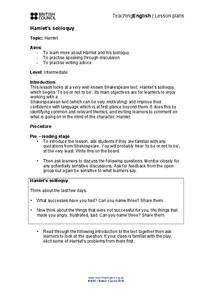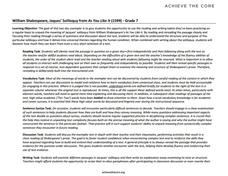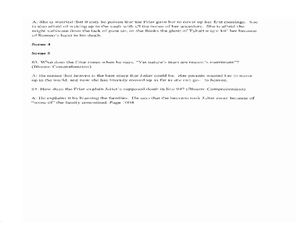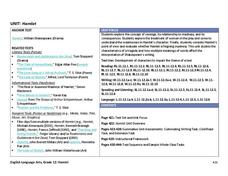Curated OER
Hamlet's Soliloquy
Everyone is familiar with the beginning of Hamlet's soliloquy, "To be or not to be..." While reading Hamlet, help your middle schoolers analyze the lines that follow, but how do you help them make personal connections to the text? Use...
Utah Education Network (UEN)
Hamlet Soliloquy Artwork
Though this assignment may be thought madness, there is an actual method. Scholars perform a close reading of the original text of the soliloquies in Hamlet and modern translations to ensure they understand the speeches. They then select...
Curated OER
Soliloquy Performances
Students investigate soliloquies. In this performing arts lesson, students discuss figurative language within soliloquies and then perform a soliloquy to the rest of the class.
Curated OER
"As You Like It" by William Shakespeare
Jacque's soliloquy from Act II, scene ii of As You Like It sets the stage for a close reading exercise that models how to approach difficult, dense text and enables readers to practice reading comprehension and analysis...
Curated OER
Shakespeare: Hamlet's Soliloquy
Twelfth graders use the Internet to find Prince Charles' version of the Hamlet soliloquy, read and discuss Hamlet's To be or not to be soliloquy and, using the study guide questions, read and discuss Prince Charles' update of the soliloquy.
Curated OER
Appreciating the Language and Interpreting the Meaning of Hamlet's Soliloquy
Students analyze Hamlet's soliloquy, "To be or not to be." In this Hamlet lesson, students define unfamiliar words in the soliloquy and interpret the lines. Students then read the lines aloud and identify descriptive words....
Curated OER
Illuminating Our Human Experiences: Soliloquy from Hamlet
Students determine the meaning of a soliloquy and examine the themes in Shakespeare's, Hamlet. In this literature lesson, students read Hamlet's soliloquy and watch a Photo Story 3 text model of such. They write a personal soliloquy...
Curated OER
Unlocking Soliloquies and Unleashing "the Dogs of War"
What is a soliloquy, and who is Julius Caesar? Explore soliloquies with this lesson plan that gets your kids up and moving! Learners line up, facing each other. Then they read the soliloquy (one side reads one line, and the other side...
Curated OER
Rewriting Shakespeare
Have your learners play around with Shakespeare's language. In this plan, small groups examine and rearrange soliloquies from Othello, noting how the language changes and morphs. All groups have a chance to change each soliloquy, making...
EngageNY
Grade 9 ELA Module 1: Unit 3, Lesson 11
The study of Romeo and Juliet continues as pairs use the provided summary tool worksheet to record evidence of how Shakespeare uses dramatic irony to heighten the tension in Juliet's soliloquy in Act 3, scene 2, lines 1–31.
EngageNY
Grade 11 ELA Module 1: Unit 2, Lesson 11
What is Hamlet's attitude towards life and death in Shakespeare's Hamlet? Scholars continue reading the play to answer the question, paying particular attention to Hamlet's most famous soliloquy. By holding a discussion and completing...
Curated OER
Satire and The Adventures of Huckleberry Finn
Does Mark Twain’s satire become sarcasm and does he cross the line of propriety in The Adventures of Huckleberry Finn? As an introduction of satire, class members view an excerpt from The Daily Show and discuss Stewart's use of this...
Curated OER
Boys Will Be Boys...Right?
Through this exercise, high schoolers identify character traits present in Romeo and Juliet. They listen to an excerpt from "The Office of Christian Parents: Showing How Children Are to be Governed" and participate in a Socratic...
EngageNY
Grade 11 ELA Module 1: Unit 2, Lesson 4
How does a soliloquy differ from a monologue? Scholars read the first soliloquy from Shakespeare's Hamlet and compare it to Claudius's monologue. They also engage in a group discussion about Hamlet's character development.
EngageNY
Grade 11 ELA Module 1: Unit 2, Lesson 9
Hamlet has an unusual take on the criminal justice system when he decides to determine his uncle's guilt by staging a play. With the resource, scholars continue analyzing Hamlet's third soliloquy from Act 2.2 of Shakespeare's Hamlet....
Curated OER
Close Reading
Eleventh graders read and study Hamlet. Then they are introduced to close reading as a means of understanding what is being read--not only understanding the printed word, but also the nuances and connotations of language as it is used by...
Curated OER
Sculptures of the Seven Ages
Students simulate sculptors and clay to help them explain abstract phrases in a soliloquy.
Curated OER
Emulating Shakespeare: To Snooze or Not To Snooze
Young scholars reproduce the pattern of one of Shakespeare's soliloquies, but use their own ideas and words to replace the character's. They replace each word with a word of their own that serves the same purpose.They discuss the speaker...
Curated OER
Scatterbrained Soliloquies
Students reconstruct a famous soliloquy from Romeo and Juliet which the teacher has cut apart and scattered. They piece the soliloquy back together making sense of the passage.
Curated OER
The Story Behind the Horse
Students view and interpret Dan Howard's artwork entitled, Soliloquium:IV. They write a story of what they think is behind the painting and then paint their own soliloquy.
Curated OER
Macbeth - Analyzing Characterization in Drama
The writing activity in this lesson could be used to assess student understanding of previously taught concepts of how language reveals character.
Louisiana Department of Education
Unit: Hamlet
Encourage readers to determine if Hamlet's madness is actually divinest sense. Class members analyze the words of the play before studying related texts, including T.S. Eliot's "The Love Song of J. Alfred Prufrock," scenes from...
EngageNY
Grade 10 ELA Module 4: Unit 2, Lesson 9
How does Shakespeare develop the central idea of agency versus fate in Macbeth? Using the resource, pupils work in small groups to discuss the plot of Act 3.1. Next, they complete a brief writing assignment to analyze how the main idea...
EngageNY
Grade 10 ELA Module 4: Unit 2, Lesson 10
Is it better to be dead than to "dwell in doubtful joy," as Lady Macbeth suggests in Act 3.2 of Shakespeare's Macbeth? Using the resource, scholars work in small groups to discuss how Lady Macbeth and Macbeth begin to unravel following...
Other popular searches
- Hamlet's Soliloquy
- Julius Caesar Soliloquy
- Hamlet Soliloquy
- Asides and Soliloquy
- Shakespeare Soliloquy
- Romeo and Juliet Soliloquy
- Macbeth Soliloquy
- Hamlets Soliloquy
- Hamlet and Soliloquy
- Drama Shakespeare Soliloquy

























